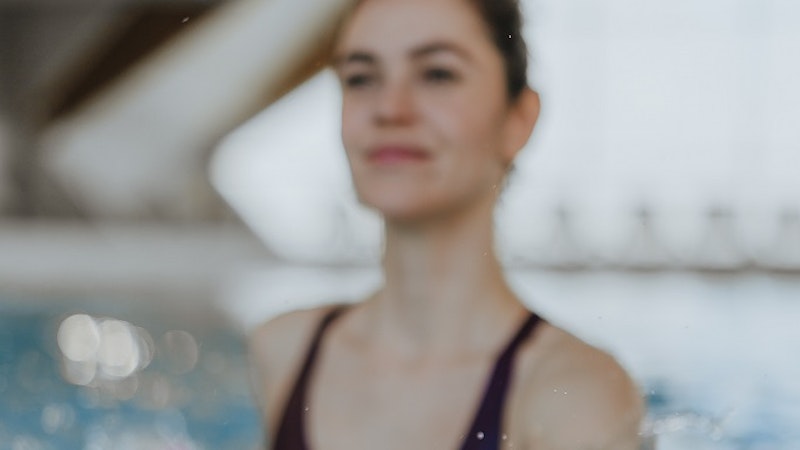Wellness
Aqua-Pilates: Pilates takes to the water!

Aqua-Pilates, a gentle, all-round workout

Wellness

Aqua-Pilates, a gentle, all-round workout
You may have tried Pilates, but have you heard of aqua-Pilates? This gentle aquatic activity combines cardiovascular training, muscle strengthening, and breathing exercises. The aim of Pilates is to work all the stabilizing muscles – both deep and superficial – while putting the body in a state of imbalance. Directly inspired by Pilates, aqua-Pilates is an original discipline open to all and practiced in warm water. The teams at Sofitel Quiberon Thalassa Sea & Spa are always delighted to talk about this increasingly popular activity.
Until recently, Pilates was only practiced indoors, but now it is available in swimming pools – much to the delight of water enthusiasts. Combining fitness and enjoyment, aqua-Pilates can be practiced with or without accessories, depending on the exercises and benefits required.
Aqua-Pilates is a comprehensive discipline that gently works the entire body in a targeted way. Without ever rushing the movement of limbs or joints, aqua-Pilates mobilizes deep muscles by putting the body in a constant state of imbalance.
“The aim is to work all the muscles while maintaining balance and alignment of the body from head to toe. This draws on the fundamentals of Pilates for both body and mind, including centering the body, placing the pelvis in a neutral position, thoracic breathing, keeping the shoulders low, and maintaining concentration and fluidity.”
Thoracic breathing is essential. The strength of the core contributes to good stability. In the water, every movement and gesture is both fluid and slow, but requires a certain amount of concentration to be carried out properly. Movements in the water generate certain imbalances and a potential decentering of the body, which forces you to self-correct by remaining contracted and centered. Posture will then gradually improve with each session.

This gentle activity is open to all, including athletes, non-athletes, men, and women of all ages. And you don’t have to know how to swim! Aqua-Pilates combines all the virtues of Pilates with the benefits of seawater heated to 32°C.
Exercises are adapted to each individual’s physical condition. They start with the feet on the ground, and are then performed while floating. There are no contraindications, and no risk of injury, falls, or joint trauma. What’s more, immersion in water prevents any compression of the spine. Heated seawater also facilitates a greater amplitude of movement.
“Pilates creates a synergy between body and mind. The resistance of the water makes muscles work harder, helping to open the ribcage and drain the limbs through self-massage.”
Aqua-Pilates is also recommended for people who do not feel comfortable in the water. The slow pace of the movements means that you can take your time to get used to the aquatic environment.
A typical session is attended by a small group of people in a seawater pool heated to 32°C.
“Having small classes means that everyone can concentrate. It also helps the coaches to give advice and, if needed, correct each participant so that they can enjoy the full benefits of this aquatic discipline.”
The session begins with a cardio warm-up, similar to aqua-aerobics, during which the principles and benefits of Pilates are explained. It then continues with a succession of targeted movements and breathing exercises performed with or without equipment (such as dumbbells, and floatation aids). The exercises can be simple or complex, depending on the participants. The session concludes with breathing exercises to help you relax and let go of any remaining stress.

You leave an Aqua-Pilates session in a state of relaxation, feeling like you have worked your muscles but without the usual pain or soreness! The effort is pleasant, even playful, and aided by the buoyancy of the water.
“By combining the benefits of Pilates with the action of aquatic massage, each aqua-Pilates session is both relaxing and invigorating. It gently strengthens deep, postural, back, and abdominal muscles, while working on balance and alignment.”
For an aqua-Pilates session, the equipment required is minimal, aimed at facilitating your comfort and efficiency during the exercises. It is advisable to bring a comfortable swimsuit suited to movement in the water. A towel and a water bottle are also essential to keep you hydrated and dry when you leave the pool. Some classes may require the use of specific equipment, such as boards or floating aids, to make the exercises more intense. The most important thing is to make sure that you are comfortable. This will help you get the most out of your aqua-Pilates session.
Aqua-Pilates and aqua-aerobics are both beneficial aquatic activities, but they have different objectives and methods. Aqua-Pilates focuses on strengthening deep muscles, improving posture, flexibility, and balance using Pilates principles adapted to the aquatic environment. The practice emphasizes breathing and fluid movements, with particular attention paid to technique and body alignment.
Meanwhile, aqua-aerobics is a more dynamic, cardio-based form of water gymnastics. It includes a variety of exercises designed to improve endurance, muscular strength, and general body tone, and is often performed at a faster pace and using accessories such as water dumbbells, boards, and floats to increase water resistance.